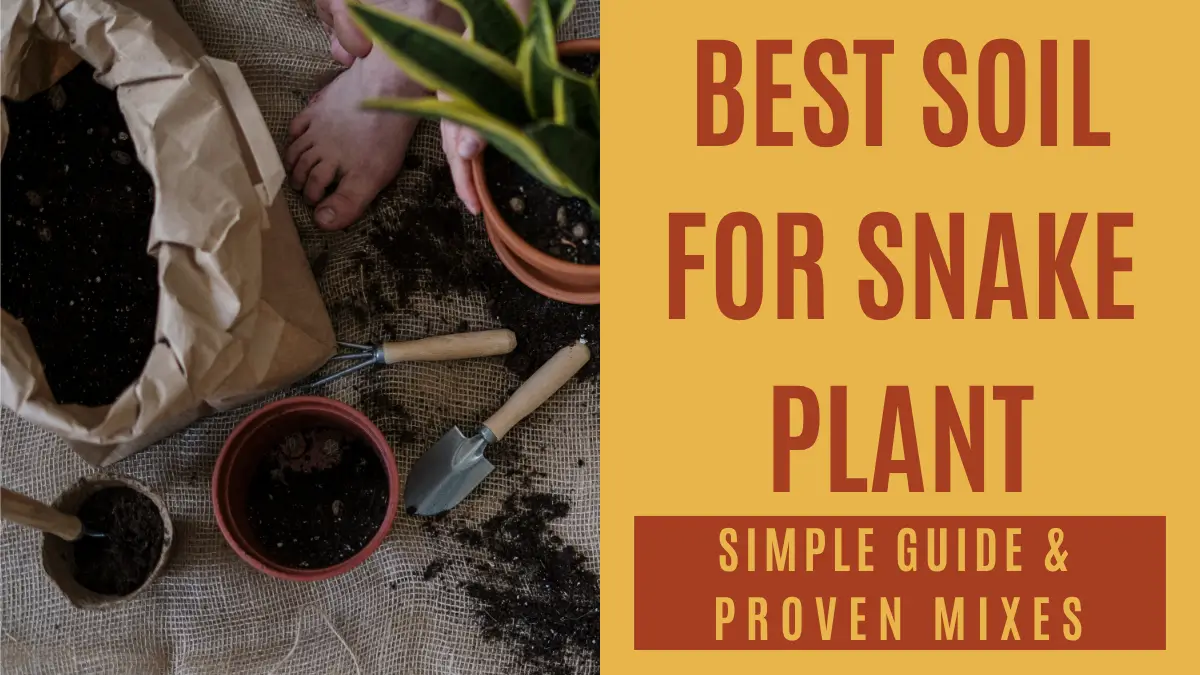Snake Plant Soil: How to Choose or Mix the Perfect Blend

Choosing the right soil is one of the most important factors in keeping your snake plant healthy and preventing root rot. While these plants are famously low-maintenance, they have very specific needs when it comes to drainage and aeration.
Having tested dozens of soil combinations on my own snake plants in Portland’s variable climate, I’ve discovered that the simplest mixes often work best. In this guide, I’ll share what actually works based on real-world experience, so you can confidently choose or create the perfect soil blend for your Sansevieria.
My Soil Philosophy: Simple & Effective
After years of experimentation, I’ve found that snake plants thrive in mixes that prioritize one thing above all else: excellent drainage. You don’t need complicated recipes—here are the approaches that deliver real results:
- For Beginners: A quality cactus or succulent potting mix provides the fast drainage snake plants need right out of the bag.
- For DIY Enthusiasts: My go-to simple blend is equal parts standard potting soil and perlite. This creates an airy, well-draining mix that’s customizable based on your watering habits.
- For Advanced Growers: A grittier mix with coarse sand and compost can mimic their natural habitat, providing both drainage and gentle nutrients.
Portland Drainage Test: Simple Mix vs. Regular Soil
To demonstrate why drainage matters, I tested two different mixes with the same watering schedule:
| Soil Mix | Drainage Time | Soil Moisture After 3 Days | Plant Response |
|---|---|---|---|
| 50/50 Potting Soil & Perlite | 15 seconds | Completely dry | New growth in 2 weeks |
| Regular Potting Soil Alone | 2+ minutes | Still damp | No new growth, slight yellowing |
The results were clear: the simple perlite mix provided the fast drainage that prevents root rot and encourages healthy growth.
What Does a Snake Plant Need from Its Soil?
The most important thing to remember: snake plants need soil that drains quickly and doesn’t stay soggy. These plants are adapted to survive in dry, rocky regions of Africa, storing water in their thick leaves and roots.
Snake plants hate sitting in wet soil. If the pot doesn’t drain well, root rot can sneak in before you even notice a problem.
So what exactly does your snake plant need from its soil? Here’s a quick breakdown from years of trial (and error!) in my plant room.
- Excellent drainage: Water should move through the mix quickly.
- Aeration: The roots need air, not just moisture. Soil that’s too dense suffocates them.
- Moderate nutrients: Snake plants aren’t heavy feeders, but a little organic matter helps.
- pH balance: Slightly acidic to neutral (pH 5.5–7.5) is ideal.
Are snake plants really as forgiving as people say?
Yes, to a point. They can survive in less-than-perfect conditions, but thriving is another story. If you want your snake plant to grow well and avoid problems like yellow leaves or mushy roots, getting the soil right is key.
➡️ If you’re new to snake plant care, master the basics with our complete care guide.
Ingredients That Work Well”
If you’re mixing your own soil, here are some components I’ve had success with. Look for these qualities rather than specific brands:
- Perlite or Pumice: These lightweight additives create air pockets and improve drainage significantly
- Coarse Sand: Helps with drainage (avoid fine play sand which can compact)
- Bark Chips: Add texture and prevent soil compaction
- Cactus Mix: A reliable base that’s formulated for excellent drainage
Snake Plant Soil Additives: Which Are Optional vs. Essential?
Over the years, I’ve seen (and tried!) all kinds of add-ins—bark, charcoal, worm tea, you name it. They’re fun to play with, but honestly? You don’t need them to make your snake plant happy. Here’s what’s optional and what’s essential:
- Essential: Add-ins that boost drainage—like perlite, pumice, coarse sand, or even chunky bark—are non-negotiable for happy snake plant roots.
- Optional: Charcoal (for odor and toxins), worm castings or compost (for nutrients), coco coir (as a peat alternative).
Add extras if you have them or want to experiment, but you don’t need a long list of ingredients. The simplest mixes work just fine for most people.
Best DIY Soil Mix for Snake Plants—Step-by-Step
For the Minimalist: One-Bag Solution
- Buy a bag of cactus or succulent mix.
- Fill your pot and plant your snake plant.
- Go easy on the water, and always wait until the top inch or two feels bone dry before reaching for that watering can.
For the DIYer: Easy Recipe
- 1 part indoor potting soil
- 1 part perlite (or pumice)
- Optional: If your mix feels a bit too dense, sprinkle in some coarse sand or bark chips. They help water flow better and keep roots breathing.
Combine ingredients in a bucket, mix thoroughly, and test by watering—water should drain through in under 30 seconds.
Tip: If you use compost or worm castings, add only a small amount (10–20%) to avoid holding excess moisture.
➡️ Different snake plant varieties may have slightly different needs—explore our variety guide to learn more.
Drainage: The Real Key to Snake Plant Success
No matter which soil mix you use, drainage is non-negotiable. Snake plants hate wet feet.
- If you can, always go for a pot with a drainage hole—your plant will thank you later.
- If you must use a pot without drainage, water very sparingly and use a very fast-draining mix. Some folks try a gravel layer at the bottom, but honestly, it’s a bit of a gamble. Proper soil and a draining pot work way better.
- Don’t use “moisture control” soils—they hold too much water.
How you water matters as much as what soil you use. Stick your finger in the soil—if the top 1–2 inches feel dry up to your first knuckle, you’re good to water.
For more on drainage and watering, see the detailed tips in this section before troubleshooting any plant issues.
Signs You’re Using the Wrong Soil for Your Snake Plant (and How to Fix It)
If your snake plant is struggling, soil could be the culprit. Watch for these warning signs:
- Yellowing or mushy leaves
- Roots that smell bad or look brown/black
- Soil stays wet for days after watering
- Slow or stunted growth
Quick fixes:
- Repot in a faster-draining mix (see recipes above)
- Add more perlite or sand to your existing soil
- Reduce watering frequency
➡️ If your plant is drooping, here’s how to diagnose and fix the issue.
➡️ Prepare your plant for colder months with our winter care tips.
Repotting Tips for Snake Plants
When to repot:
- When roots circle the pot or poke out the drainage hole
- If soil stays soggy or the plant looks unhealthy
- Every 2–3 years, or sooner if needed
➡️ Read our guide to learn how to repot a snake plant.
➡️ Also read: How often to water snake plant per season—because summer vs. winter care is not the same.

FAQs
Can I use regular potting soil only?
You can, but it’s risky—regular potting soil holds more water than snake plants like. Mix in some perlite or coarse sand for a quick drainage boost.
Is cactus mix safe for snake plants?
Absolutely. It’s often the easiest and best choice.
What if my pot has no drainage hole?
Water very carefully, use a very fast-draining mix, and consider repotting into a container with drainage if possible.
How often should I change the soil?
Every 2–3 years, or if you notice problems like root rot or compacted soil.
Cheapest way to get good soil for one plant?
Grab a small bag of cactus mix or stir a handful of perlite into your usual potting soil. No need to buy lots of extras.
Conclusion
Remember, the goal is simple: create an environment where water flows through quickly and roots can breathe. Whether you choose a pre-made cactus mix or create your own blend, focusing on drainage will keep your snake plant thriving for years to come.
Have questions, tips, or your own soil recipe to share? Drop a comment below! If you found this guide helpful, share it with a fellow plant lover or bookmark it for your next repotting session.
Ready to continue your snake plant journey?
